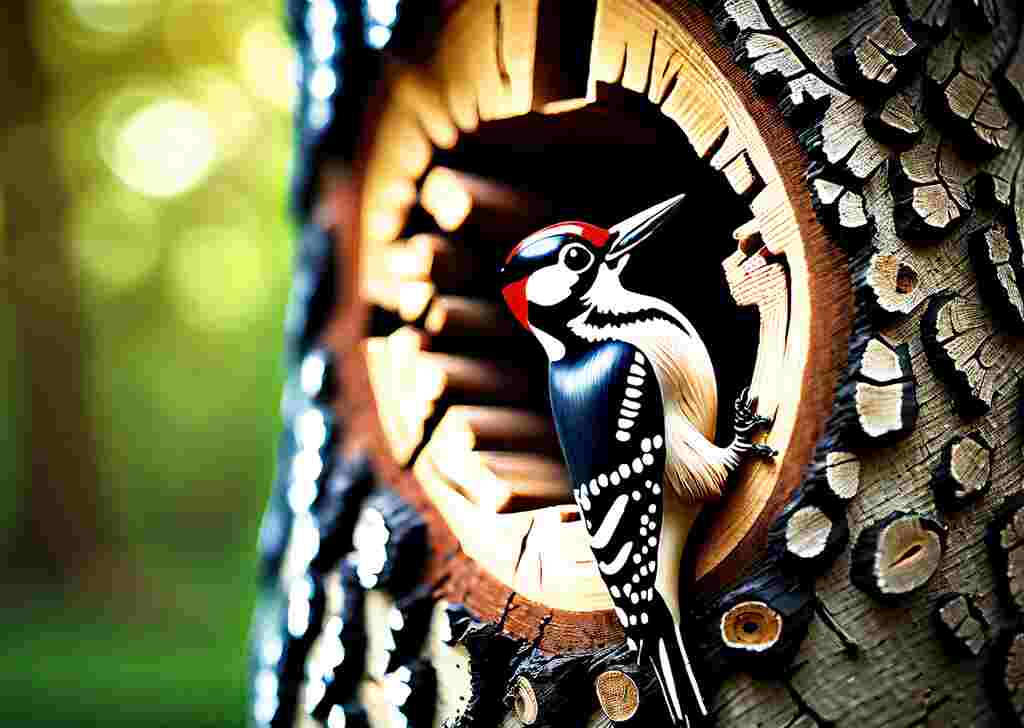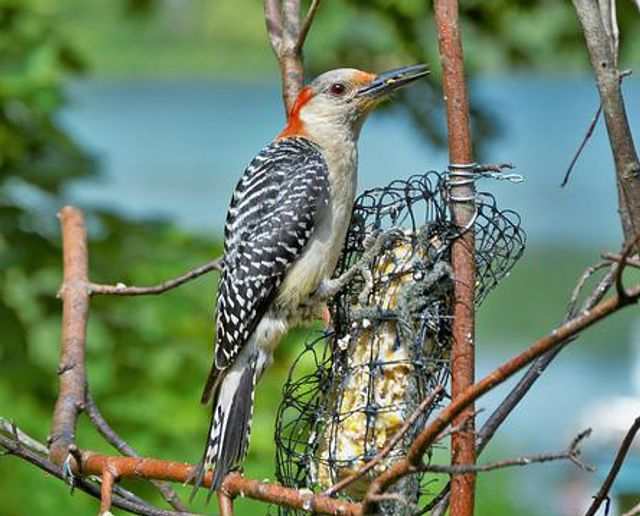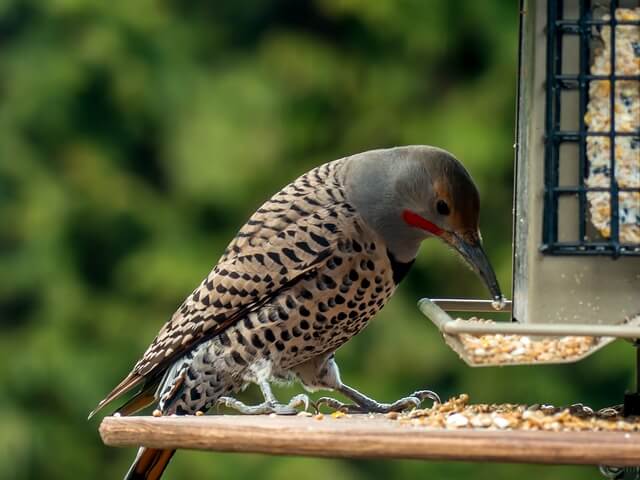Welcome to the Lone Star State, where vibrant woodpeckers rule the roost! Join us on a birdwatcher’s journey as we uncover the fascinating world of 16 woodpecker species thriving in Texas. From the iconic Pileated to the elusive Red-cockaded, get ready to explore Texas’ diverse birdlife like never before!
Table of Contents
- 1 Types of Woodpeckers in Texas
- 1.1 Red-bellied Woodpecker
- 1.2 Downy Woodpecker
- 1.3 Golden-fronted Woodpecker
- 1.4 Ladder-backed Woodpecker
- 1.5 Northern Flicker
- 1.6 Yellow-bellied Sapsucker
- 1.7 Pileated Woodpecker
- 1.8 Red-headed Woodpecker
- 1.9 Acorn Woodpecker
- 1.10 Hairy Woodpecker
- 1.11 Red-cocked Woodpecker
- 1.12 Red-naped Sapsucker
- 1.13 Lewis’s Woodpecker
- 1.14 Williamson Sapsucker
- 1.15 Red-breasted Sapsucker
- 1.16 Ivory-billed Woodpecker (Recently Extinct)
- 2 Author
Types of Woodpeckers in Texas
Red-bellied Woodpecker
- Length: 9.5 in (24 cm)
- Weight: 2.0-3.2 oz. (56-90 g)
- Wingspan: 13.0-16.5 in (33-42 cm)
- Scientific Name: Melanerpes carolinus
- Frequency of Occurrence: 16.70% (Statistic by: eBird)
- Where To Find Them: They are mostly found in the eastern part of the state, but have been seen as far west as Uvalde County. They are also quite common in the Houston area.
- How to Attract: Plant trees and bushes that are in the pecking range of a red-bellied woodpecker. These include maples, oaks, ash trees, and hickories. Include some fruit-bearing trees as well for added bonus. Install bird feeders high up on sturdy poles, so the woodpeckers have plenty of places to feed. Be sure to put out different types of foods such as suet, peanuts, meal worms, black-oil sunflower seed, cracked corn, nectar and fruit, so they have something interesting to peck at.
Description: The Red-bellied Woodpecker is a common bird found in much of the United States. It prefers hardwood forests but can be found in a variety of other habitats including parks, suburbs, and even urban areas. The Red-bellied Woodpecker feeds mainly on insects, but will also eat fruit and nuts.
Cavity nesting is the major form of reproductive behavior for this woodpecker. They excavate a hole in a tree or post, and lay 2-6 eggs. Incubation is done by both parents, and the chicks fledge around 11 weeks after hatching.
Handpicked Related Content: How to Attract Red-bellied Woodpeckers to your Yard?
Downy Woodpecker
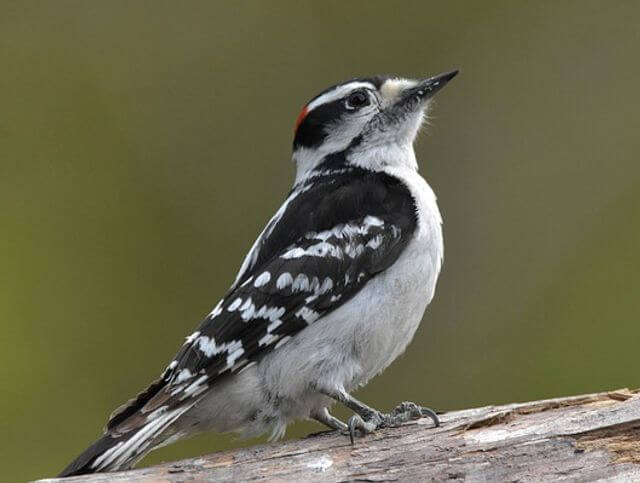
- Length: 5.5-6.7 in (14-17 cm)
- Weight: 0.7-1.0 oz. (21-28 g)
- Wingspan: 9.8-11.8 in (25-30 cm)
- Scientific Name: Picoides pubescens
- Frequency of Occurrence: 12.42%
- Where To Find Them: Downy woodpeckers are one of the most common woodpecker species in Texas. They can be found in many parts of the state, but some areas that are particularly good for spotting them include the Hill Country, the Coastal Bend, and East Texas.
- How to Attract: Plant deciduous trees and shrubs that provide plenty of cover for these birds. Downy Woodpeckers like to stay in wooded areas, so providing a shady perch is important for them. Invest in bird feeders that have downy woodpecker-specific designs or make sure there are plenty of food options available, such as cracked corn and suet cakes. You can also try placing water sources nearby, especially during the winter, when most woodpeckers are thirsty.
Description: The Downy Woodpecker is a common bird in the Northeast United States. It ranges throughout most of the eastern half of the United States, with a few populations found in the Midwest. The Downy Woodpecker is an adaptable bird and can be found in a variety of habitats, including deciduous and mixed forests, open fields, and suburban areas.
It feeds on insects, especially small wood pests such as wood boring beetles, carpenter ants and termites. The Downy Woodpecker nests in cavities in trees, usually choosing dead or weakened trees.
Handpicked Related Content: How to Attract Downy Woodpeckers to Your Yard? (Easy!)
Golden-fronted Woodpecker

- Length: 8.7-10.2 in (22-26 cm)
- Weight: 2.6-3.5 oz (73-99 g)
- Wingspan: 16.5-17.3 in (42-44 cm)
- Scientific Name: Melanerpes aurifrons
- Frequency of Occurrence: 11.77%
- Where To Find Them: The Golden-fronted Woodpecker is a common bird in Texas. They can be found in many different parts of the state, including the Dallas/Fort Worth area and Houston.
- How to Attract: One of the first things you can do is try planting trees and shrubs that provide a variety of food options and nesting areas. The golden-fronted woodpecker loves eating insects, so including plenty of bug-eating plants in your landscaping will give them plenty of sustenance. Next, try setting up a bird feeder filled with peanuts, black-oil sunflower seeds, cracked corn, acorns, peanuts, bananas, oranges. Another way to attract these birds is by creating areas that are sheltered from bad weather and predators. I would also recommend setting up bird baths near your feeders.
Description: The distribution range of the Golden-fronted Woodpecker extends from southern California east to Texas and north to central Illinois. The woodpecker prefers moist forests, but can also be found in other types of habitats including oak woodlands, chaparral, riparian areas and even urban areas.
They are cavity nesters, constructing their nests in high tree limbs or dead trees. The diet of the golden-fronted woodpecker consists primarily of insects, although they will also consume small fruits, seeds and nuts.
Ladder-backed Woodpecker
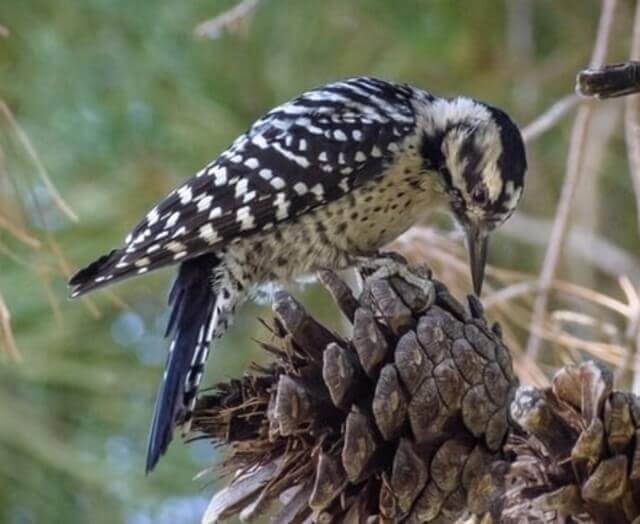
- Length: 6.3-7.1 in (16-18 cm)
- Weight: 0.7-1.7 oz (21-48 g)
- Wingspan: 13.0 in (33 cm)
- Scientific Name: Dryobates scalaris
- Frequency of Occurrence: 10.45%
- Where To Find Them: Ladder-backed Woodpeckers are found throughout much of Texas, but they are particularly common in the Edwards Plateau region. They can also be found in the Hill Country and in statewide areas like Austin and San Antonio.
- How to Attract: Plant a variety of trees and shrubs in your yard that the birds can use for nesting. This will include trees like maple, oak, birch, and pine. Make sure there is plenty of grub for the birds in your garden – this includes things like insects, worms, and larvae. Provide water sources in your yard – these can be fountains or ponds.
Description: The ladder-backed woodpecker is a medium-sized bird that can be found in the eastern half of North America. It is a migratory bird, spending winters in Central and South America. The ladder-backed woodpecker inhabits a variety of habitats, including deciduous and mixed forests, open fields and orchards, and urban areas.
Its diet consists mostly of insects, such as ants, termites, caterpillars, insect larvae, wood-boring beetles, leafworms, and many more. The ladder-backed woodpecker nests in cavities in trees.
Northern Flicker
- Length: 11.0-12.0 in (28-31 cm)
- Weight: 3.9-5.6 oz. (110-160 g)
- Wingspan: 16.5-20.0 in (42-51 cm)
- Scientific Name: Colaptes auratus
- Frequency of Occurrence: 4.28%
- Where To Find Them: Here are some Northern Flicker locations in Texas: The Franklin Mountains State Natural Area near Navasota has a good concentration of birds, while the Fort Worth Nature Center has a large variety of bird species. The Dallas Arboretum at Fair Park is also a great place to see Northern Flickers.
- How To Attract: Plant a mix of deciduous and conifer trees in your yard. The Northern flicker especially likes fruit-bearing trees, so be sure to add some varieties that will provide them with sustenance. Make sure there is enough vegetation around the base of the trees for the birds to perch on. Provide woodlands and dense shrubbery as well for additional nesting and hiding options. Install bird feeders with a wide variety of food options, including insect suet and meal worms, sunflower seeds, nuts and fruits.
Description: The Northern Flicker (Colaptes auratus) is a common woodpecker found in the eastern and central United States. The bird has a distribution range that extends from Maine south to Florida, west to Texas, and north to Wisconsin. The Northern Flicker frequents various types of forests, including hardwood, oak-hickory, and pine.
The flicker also favors deciduous trees such as maples, oaks, and birches. The Northern Flicker feeds primarily on insects, but will also eat fruits and seeds in summer if they are available. These birds excavate holes in dead trees or other cavities using their bills.
Handpicked Related Post: How to Attract Northern Flickers to your Backyard (Easy)
Yellow-bellied Sapsucker

- Length: 7.1-8.7 in (18-22 cm)
- Weight: 1.5-1.9 oz. (43-55 g)
- Wingspan: 13.4-15.8 in (34-40 cm)
- Scientific Name: Sphyrapicus varius
- Frequency of Occurrence: 3.13%
- Where To Find Them: They can be found in Texas, but certain locations are better than others for finding them. One good spot to find them is in the Sabine National Forest.
- How to Attract: If you want to attract this bird to your yard, there are a few things you can do. First, make sure there are plenty of sources of insects around – they love them! Secondly, provide some tall branches near your home, so the sapsucker can perch easily. Finally, make sure your yard is clean and free of debris – this bird loves to build nests!
Description: The Yellow-bellied Sapsucker is found in the eastern United States, from Maine south to Florida and west to Texas. It can be found in a variety of habitats, including open forests, deciduous and mixed woods, and recently burned areas.
The sapsucker prefers to feed on insects in the canopy of trees, but will also consume tree sap, insects, fruits, and nuts if available. The yellow-bellied sapsucker typically nests in cavities in trees, but has been known to nest in other structures, such as abandoned nests or birdhouses.
Handpicked Related Post: 16 Interesting Sapsucker Facts Revealed!
Pileated Woodpecker
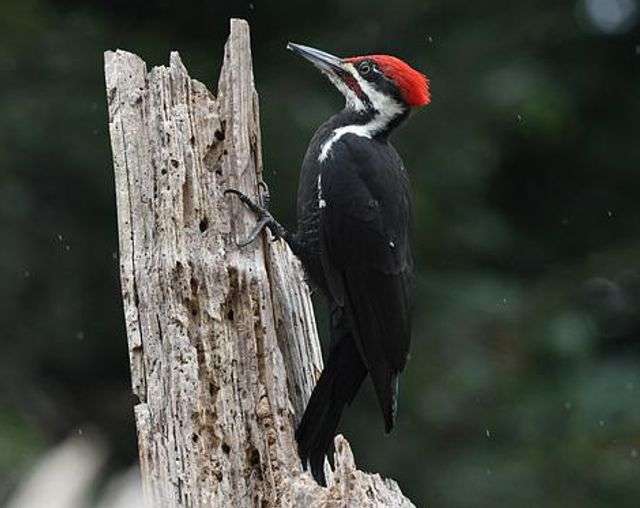
- Length: 15.8-19.3 in (40-49 cm)
- Weight: 8.8-12.3 oz. (250-350 g)
- Wingspan: 26.0-29.5 in (66-75 cm)
- Scientific Name: Dryocopus pileatus
- Frequency of Occurrence: 3.03%
- Where To Find Them: Pileated Woodpecker distribution in Texas is patchy, with concentrations found mainly in the Trans-Pecos and the Big Bend regions. In Texas, they can be found throughout much of the eastern two-thirds of the state, and in a few isolated pockets in the west. Outside their breeding range, they can also be found along the Gulf Coast.
- How To Attract: Make sure you have lots of trees and shrubs in your yard that they can perch on. A tall tree will also help attract their attention. Try putting up a feeder full of fresh fruit or seed in your yard. Woodpeckers love to eat fresh food, so this will definitely interest them. Keep an eye out for fallen logs or branches that the woodpeckers can use as perches. They will often work on these materials until they are ready to fly away again.
Description: The Pileated Woodpecker is a large woodpecker found in the eastern United States. It ranges from the Appalachian Mountains to the Florida Keys and west to Texas. This bird lives in forested areas, but can also be found in open fields near trees.
The Pileated woodpecker’s diet consists mainly of insects, such as ants, beetles, caterpillars, although it will occasionally eat fruits, seeds or nuts. It nests in cavities in trees, usually high up so that other animals cannot reach the eggs or young.
Handpicked Related Post: How to Attract Pileated Woodpeckers to your Yard (Fast)
Red-headed Woodpecker
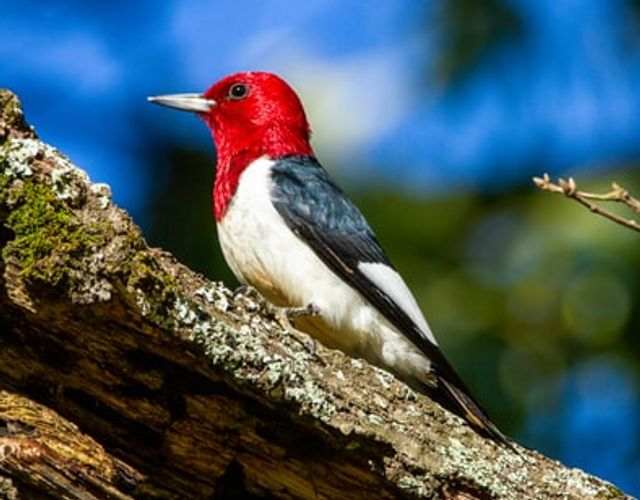
- Length: 7.5-9.1 in (19-23 cm)
- Weight: 2.0-3.2 oz. (56-91 g)
- Wingspan: 16.5 in (42 cm)
- Scientific Name: Melanerpes erythrocephalus
- Frequency of Occurrence: 1.22%
- Where To Find Them: Some of the areas where red-headed woodpeckers can be found in Texas include the Gulf Coast region, the Piney Woods region, and parts of the Hill Country.
- How to Attract: Plant a tree or fruit tree in your yard that the red-headed woodpecker will enjoy. Try a apple, cherry, pear, or grapefruit tree. Hang bird feeders in strategic locations in your yard so the woodpeckers have plenty of food to eat. Make sure your garden is full of flowers and shrubs that provide cover for the birds. This will make them feelsafe and secure while they forage for food. Keep areas of your yard clean so the woodpeckers can find food easily.
Description: The Red-headed Woodpecker is a common woodpecker in the eastern United States. The distribution range includes most of the eastern United States, from southern Canada to northern Florida. This species prefers deciduous and mixed forests with overhead cover such as tree limbs, but can also be found in coniferous forests.
The diet consists mainly of insects, but will sometimes take small fruits or seeds. This species nests in cavities high up in trees, usually choosing old trees that have been damaged by fire or hurricane.
Handpicked Related Post: Interesting Red-Headed Woodpecker Facts (Explained)
Acorn Woodpecker
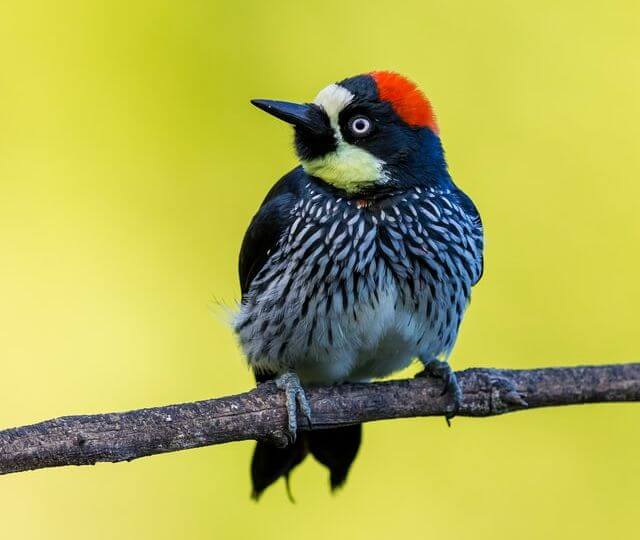
- Length: 7.3-9.4″ in (18.5-24.0 cm)
- Weight: 2.3-3.2 oz. (65-90 g)
- Wingspan: 13.8-17.7 in (35-45 cm)
- Scientific Name: Melanerpes formicivorus
- Frequency of Occurrence: 0.6190%
- Where To Find Them: In the Hill Country region of Central Texas, the Acorn Woodpecker can be found at Burnet and Travis Counties. In East Texas, the Acorn Woodpecker can be found near Rusk and Kaufman Counties. In Southeast Texas, the Acorn Woodpecker can be found near Angelina and Austin Counties. In South Texas, the Acorn Woodpecker can be found near Bexar County.
- How To Attract: A simple way to attract this woodpecker is by providing them with plenty of food sources, including insects, nuts and seeds. You can also set up some perches, or even a bird bath for them in your yard so they have a place to rest and watch the goings on around them.
Description: Acorn Woodpecker is a large woodpecker that ranges throughout much of North America. This bird is most common in the eastern half of the US, but can also be found in Canada and Mexico. The woodpecker prefers deciduous and mixed forests, but can also be found in areas with some open woodland.
They mainly feed on acorns and insects, but will also feed on fruits, seeds, and bird’s eggs. The Acorn Woodpecker is a cavity nester, constructing its nest out of tree bark, wood chips, and other materials, although they have also been known to use artificial nest boxes.
Hairy Woodpecker
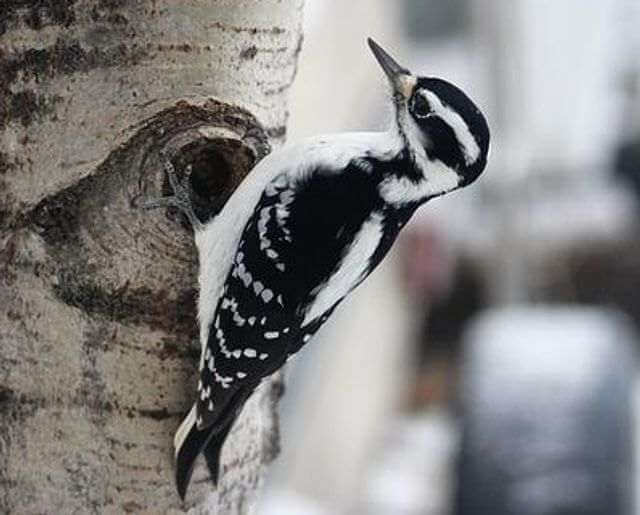
- Length: 7.1-10.2 in (18-26 cm)
- Weight: 1.4-3.4 oz. (40-95 g)
- Wingspan: 13.0-16.1 in (33-41 cm)
- Scientific Name: Picoides villosus
- Frequency of Occurrence: 0.3695%
- Where To Find Them: This woodpecker can be found throughout much of Texas, but is especially common in the Hill Country and Gulf Coast regions.
- How To Attract: The hairy Woodpecker is a beautiful bird that you can easily attract to your yard with some simple steps. First, start by creating a nice habitat for the woodpecker to live in. Try planting shrubs and trees near the ground that provide plenty of nesting sites and perches. Next, create food sources for the birds by planting fruits or installing bird feeders with black-oil sunflower seeds close to your home. Finally, make sure to keep your yard clean and free of debris, so the woodpecker can find easy access to food and shelter.
Description: Hairy Woodpeckers are found throughout the eastern and central United States. They prefer to live in forests, but can also be seen in other wooded areas. These birds have a wide distribution range, so you may see them anywhere from the Appalachian Mountains to the coastal plain of Georgia.
The hairy woodpecker is an insectivore, and its diet consists mainly of insects. It usually forages on tree branches or trunks, but it will also eat some berries, seeds, and nuts. The hairy woodpecker constructs its nest in a cavity in a tree trunk or branch.
Red-cocked Woodpecker

- Length: 7.0–9.0″ in. (17.8-22.9 cm)
- Weight: 1.4–2.0 oz. (40–56 g)
- Wingspan: 13–16″ in. (34-41 cm)
- Scientific Name: Leuconotopicus borealis
- Frequency of Occurrence: 0.1247%
- Where To Find Them: They can be found in many areas of the state, including the Dallas/Fort Worth and Houston metropolitan areas.
- How To Attract: You can attract red-cockaded woodpeckers to your yard by providing them with a food source, such as bird feeders or fruit trees. You can also add nest boxes to your yard for the woodpeckers to use.
Description: The Red-cocked Woodpecker is a common bird in the eastern United States. It has a distribution range that includes much of the eastern half of Canada and parts of northern Mexico. The woodpecker prefers deciduous or mixed forests, but will also inhabit areas with some coniferous trees.
The diet consists primarily of insects, such astermites, beetles, ants, spiders, roaches, and more, but they will also eat small fruits and some seed. Nesting habits are typical for woodpeckers – they excavate an elaborate hole in a tree to lay their eggs.
Red-naped Sapsucker
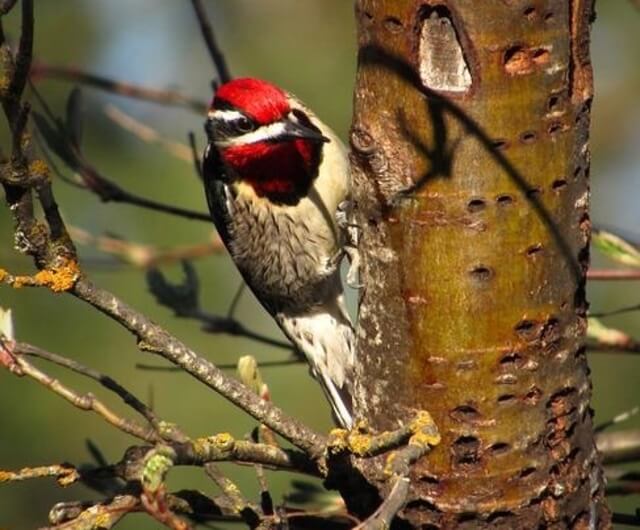
- Length: 7.1-8.7″ in (18-22 cm)
- Weight: 1.1-2.3 oz. (32-65 g)
- Wingspan: 15.7-17.3″ in (40-44 cm)
- Scientific Name: Sphyrapicus ruber
- Frequency of Occurrence: 0.1131%
- Where To Find Them: The birds can be found in areas such as the Brazos Valley and Dallas County. Finally, if you’re looking for red-naped sapsuckers near Austin, look for areas around Lake Travis.
- How To Attract: A bird that is often seen in parks and gardens is the red-naped sapsucker. This bird is attracted to nesting boxes, or other areas where it can build a nest. If you want to attract this bird to your yard, make sure you have nesting boxes available and make sure they are in a good location. You can also try planting trees that are attractive to this bird, such as the white oak or the chestnut tree.
Description: The Red-naped Sapsucker is a cavity nester that is found throughout much of North America.It can also be found in Argentina, Bolivia, Brazil, Chile, Colombia, Ecuador, French Guiana, Guyana, Peru, Suriname and Venezuela. Its environments are subtropical or tropical rain forests along with moist high mountain woodlands.
The red-naped sapsucker feeds on insects caught in the tree canopy, but also feeds on tree sap, berries and fruit. This bird nests in cavities in trees, but has also been known to use old woodpecker holes.
Lewis’s Woodpecker

- Length: 10.2-11.0 in (26-28 cm)
- Weight: 3.1-4.9 oz. (88-138 g)
- Wingspan: 19.3-20.5 in (49-52 cm)
- Scientific Name: Melanerpes lewis
- Frequency of Occurrence: 0.0233%
- Where To Find Them: The Lewis’s Woodpecker is a unique bird that can be found in a few locations in Texas. They can be found in the Big Thicket, the Rio Grande Valley, and in West Texas.
- How to Attract: There are a few things you can do to attract Lewis’s Woodpeckers to your yard. One thing is to plant trees that produce nuts, such as oak or hickories. These trees may provide food for the woodpeckers as they peck at the nuts. Another way to attract these birds is by installing a bird feeder with mealworms or suet..
Description: The Lewis’s Woodpecker is a large woodpecker that can be found throughout most of North America. The Lewis’s Woodpecker ranges from the Arctic tundra to sub-tropical areas of Mexico. The habitat preference of this bird includes hardwood forests with someconiferous trees mixed in.
This species feeds mainly on a wide variety of insects, but will also eat small amounts of nuts, berries and fruit. Lewis’s Woodpecker nests in cavities in trees, usually starting to build a nest around late February or early March. They typically lay 5-9 eggs, which are incubated for about 12 days by both sexes and fledge about five weeks later.
Williamson Sapsucker

- Length: 7.9-9.8″ in. (20-25 cm)
- Weight: 1.6-1.9 oz (44-55 g)
- Wingspan: 16.5-17 in (42-43 cm)
- Scientific Name: Sphyrapicus thyroideus
- Frequency of Occurrence: 0.0156%
- Where To Find Them: The Williamson Sapsucker is a small woodpecker found in the Lower Rio Grande Valley of Texas. The species can be found in the counties of Cameron, Hidalgo, Starr and Willacy. The bird can also be found near the edges of deciduous and mixed forests, as well as near open fields.
- How to Attract: Williamson Sapsuckers like areas with plenty of trees that provide sap, and shrubs for cover, as well as some open ground. Second, try to provide them with food sources. This includes insects, nuts and seeds, and sometimes even fruit.
Description: The Williamson Sapsucker (Sphyrapicus thyroideus) is a North American woodpecker that breeds in the eastern and central United States. The distribution range of the species includes most of the eastern seaboard, south to Florida and Texas, and west to Ontario and Nebraska. The habitat of this species is mixed deciduous forest, with an emphasis on areas with tall trees.
The diet of the Williamson Sapsucker consists principally of insects such as ants, but also includes tree sap, berries and fruit. The Williamson Sapsucker typically nests in cavities in large trees, but has been known to nest in other places including abandoned woodpecker holes and even nest boxes.
Red-breasted Sapsucker
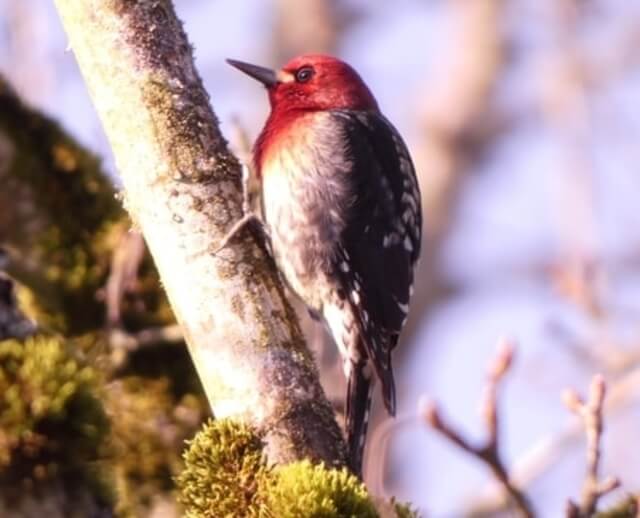
- Length: 7.9-8.7″ in. (20-22 cm)
- Weight: 1.9-2.2 oz. (53.0-63.5 g)
- Wingspan: 14.2-16.0″ in. (36-40.5 cm)
- Scientific Name: Sphyrapicus varius
- Frequency of Occurrence: 0.0002%
- Where To Find Them: The only places where they are found in significant numbers are along the Gulf Coast and in the Big Thicket National Preserve.
- How to Attract: First, make sure the area you choose has plenty of trees and shrubs for them to perch in. Also, make sure the ground around your yard is covered with some type of food source, like bugs, worms and trees with sap. Finally, don’t forget to give them some space – they’re territorial birds!
Description: The Red-breasted Sapsucker is one of the most common and widespread birds in North America. They are found across most of the eastern half of the continent, as well as parts of the west. They prefer open areas with lots of trees and shrubs, but can also be found in residential areas. The Red-breasted Sapsucker is a passerine bird that feeds mainly on insects, arthropods, fruit, and seeds.
They will perch on tree branches and feed on small creatures that fly or crawl near their nests. They build their nests in cavities in trees, usually near the top. There are usually 4-8 eggs laid and incubated by the female for 12-14 days. The young birds leave the nest after about 10 days and are independent within a few weeks.
Ivory-billed Woodpecker (Recently Extinct)

- Length: 19-21″ in. (48.3-53.3 cm)
- Weight: 454 to 567 g (1.00 to 1.25 lb)
- Wingspan: 29.5-31.5″ in. (75-80 cm)
- Scientific Name: Campephilus principalis
- Frequency of Occurrence: 0.0000%
- Where To Find Them: Some of the places where they can be found include the Big Thicket National Preserve, Hackberry Creek State Park, and Jefferson Davis National Forest. The best time to see them is during the fall when they are hunting for insects.
- How to Attract: One way to attract the Ivory-billed Woodpecker is by providing them with tall trees or other large structures in their habitat that they can use for nesting. Another way to attract this bird is by planting fruit trees in your yard, as they are known to eat a variety of fruits. You can also try setting up a bird feeder with acorns or meal worms in your yard, which will provide them with food.
Description: Ivory-billed Woodpecker were once common throughout the southeastern United States, but their populations have drastically declined in recent years. They are now considered to be extinct. The primary cause of their decline is believed to be habitat loss and fragmentation.
Ivory-billed Woodpeckers primarily inhabit hardwood forests, but they can also be found in mixed deciduous and hardwood forests, as well as in riparian areas. They feed on insects such as beetles, beetle larvae, termites, and ants, but will also feed on fruits, seeds and nuts. They build cavities in trees for nesting purposes.
Related Post: 20 Most Common Backyard Birds In Texas (Explained)

